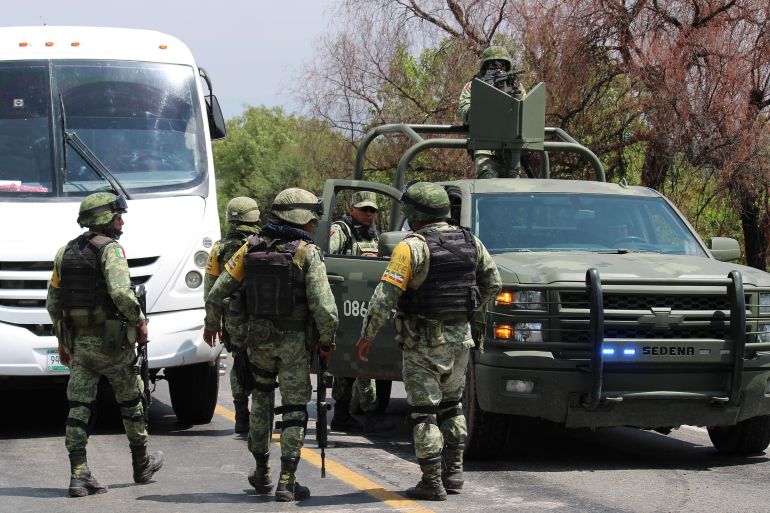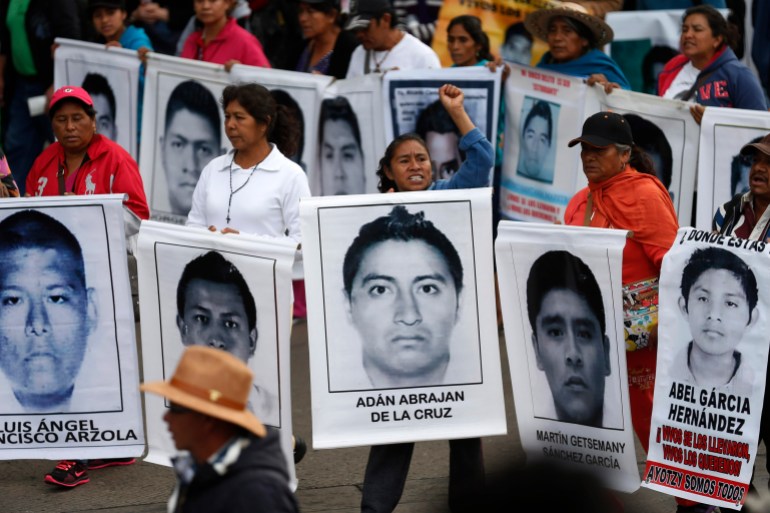Six of 43 missing Mexico students were given to army: Official
The revelation by a top official ties the military to one of Mexico’s worst human rights scandals.

Six of the 43 students “disappeared” in 2014 were allegedly kept alive in a warehouse for days then turned over to the local army commander who ordered them killed, the Mexican government official leading a Truth Commission said on Friday.
Interior undersecretary Alejandro Encinas made the shocking revelation directly tying the military to one of Mexico’s worst human rights scandals, and it came with little fanfare as he made a lengthy defence of the commission’s report released a week earlier.
Keep reading
list of 3 itemsMexico arrests former top prosecutor over missing students case
Truth commission faults Mexico military over 43 missing students
President Andrés Manuel López Obrador established the Truth Commission after he was elected to office in 2018.
Last week, despite declaring the abductions and disappearances a “state crime” and saying that the army watched it happen without intervening, Encinas made no mention of six students being turned over to Colonel José Rodríguez Pérez.
On Friday, Encinas said authorities were closely monitoring the students from the rural teachers’ college at Ayotzinapa from the time they left their campus through to their abduction by local police in the town of Iguala that night. A soldier who had infiltrated the school was among the abducted students, and Encinas asserted the army did not follow its own protocols and try to rescue him.
“There is also information corroborated with emergency 089 telephone calls where allegedly six of the 43 disappeared students were held during several days and alive in what they call the old warehouse and from there were turned over to the colonel,” Encinas said.
“Allegedly the six students were alive for as many as four days after the events and were killed and disappeared on orders of the colonel, allegedly the then-Colonel José Rodríguez Pérez,” he added.
The role of the army in the disappearance
The defence department did not immediately respond to a request for comment about the allegations on Friday.
The role of the army in the students’ disappearance has long been a source of tension between the families and the government.
From the beginning, there were questions about the military’s knowledge of what happened and its possible involvement. The students’ parents demanded for years that they be allowed to search the army base in Iguala. It was not until 2019 that they were given access, along with Encinas and the Truth Commission.
The commission report says the army registered an anonymous emergency call on September 30, 2014, four days after the students’ abduction.
The caller reportedly said the students were being held in a large concrete warehouse in a location described as “Pueblo Viejo.” The caller proceeded to describe the location.
That entry was followed by several pages of redacted material, but that section of the report concluded with the following: “As can be seen, obvious collusion existed between agents of the Mexican state with the criminal group Guerreros Unidos that tolerated, allowed and participated in events of violence and disappearance of the students, as well as the government’s attempt to hide the truth about the events.”
Later, in a summary of how the commission’s report differed from the original investigation’s conclusions, there is mention of a colonel.
“On September 30 ‘the colonel’ mentions that they will take care of cleaning everything up and that they had already taken charge of the six students who had remained alive,” the report said.
Parents protest
In a witness statement provided to federal investigators in December 2014, Captain José Martínez Crespo, who was stationed at the base in Iguala, said the base commander for the 27th Infantry Battalion at the time was Colonel José Rodriguez Pérez.
Through a driving rain later on Friday, the families of the 43 missing students marched in Mexico City with several hundred other people as they have on the 26th of every month for years.
Parents carried posters of their children’s faces and rows of current students from the teachers’ college marched, shouted calls for justice and counted off to 43. Their signs proclaimed that the fight for justice continued and asserted: “It was the State.”
Clemente Rodríguez marched for his son Christian Alfonso Rodríguez Telumbre, who was a second student identified by a tiny burned bone fragment.
Rodríguez said the families had been told last week before the report was released about the colonel and the six students.
“It’s not by omission any more. It’s that they participated,” he said of the military. “It was the state, the three levels of government participated.”
He said the families had not been told whether any of the arrest orders announced last week for members of the armed forces had been carried out yet.
On September 26, 2014, local police took the students off buses they had commandeered in Iguala. The motive for the police action remains unclear eight years later. Their bodies have never been found, though fragments of burned bone have been matched to three of the students.

Former attorney general arrested
Last week, federal agents arrested former Attorney General Jesus Murillo Karam, who oversaw the original investigation. On Wednesday, a judge ordered that he stand trial for forced disappearance, not reporting torture and official misconduct. Prosecutors allege Murillo Karam created a false narrative about what happened to the students to quickly appear to resolve the case.
Authorities also said last week that arrest warrants were issued for 20 soldiers and officers, five local officials, 33 local police officers and 11 state police officers as well as 14 gang members. Neither the army nor prosecutors have said how many of those suspects are in custody.
It was also not immediately clear if Rodríguez Pérez was among those sought.
In a joint statement, the families said the Truth Commission’s confirmation that it was a “state crime” was significant after elements suggesting that over the years.
However, they said the report still did not satisfactorily answer their most important question.
“Mothers and fathers need indubitable scientific evidence as to the fate of our children,” the statement said. “We can’t go home with preliminary signs that don’t fully clear up where they are and what happened to them.”